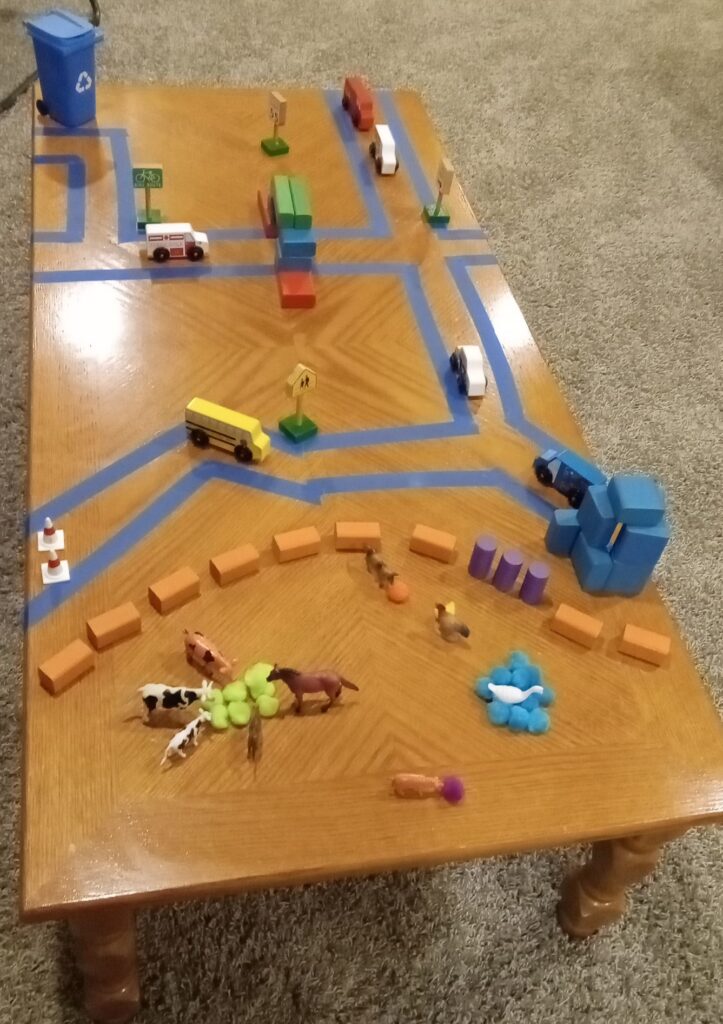
Some basic toys and a few dollars at the discount store/section and you can easily make a reusable language rich, child led play activity! This was a set up for one of my young clients. It was so much fun, I have left the tape on the table, the tub underneath and almost all of my clients under age 6 have spent multiple sessions creating and recreating little villages, farms or race ways. The possibilities are endless (especially if you add a couple different things for the next play time). I’ll admit, I was not a creative imaginative child and did not have that skill as a mom with young children; it is a skill that I have learned and practiced! Learning to follow the child’s interests has made this easier and more fun for everyone! I don’t have to have a specific plan for play – I just comment, ask a question or two, briefly play ‘my way’, add something silly, or just follow exactly what they do! Here are some ideas for different ways of incorporating language as you play with your little and some tips for different styles of play.
Items to use: painters tape to make road designs, colored pom poms (used as flowers sprinkled on the table, a pond of blue for the duck, green grass for the horse, or dirt scooped up and dumped by construction trucks), building blocks (to make bridges, schools, hospitals, fences), farm animals, and a variety of vehicles.
Toddler – make car sounds as you play – “beep beep!” “honk!” “screech!” “vrroom vroom” and “crash!” Narrate and repeat actions for Go, Stop, Turn, Fast and Slow. If you have a toy bus, sing or play the song “Wheel’s on the Bus” while moving the bus. Set the animals up, name them and make the animal sounds, use words ‘in/on’ and put the animals on or in a vehicle, take them some pretend food to eat and use sounds/words like ‘Mmm,’ ‘yummy’ ‘eww’ or ‘ick’ to get some giggles.
Three-Four years old – Use the blocks to make a bridge for the cars to go zooming under, don’t crash into the bridge or you’ll have to start again! – or do – the kids love making their own sound effects, rebuilding, the challenge of getting the vehicle under the bridge at a fast speed! This is also great for teaching cause and effect! Set up a school area, a farm area, a construction or a zoo area and have the different vehicles/animals interact with each other. This is a good way to incorporate ‘wh’ questions. Animals can fall over (or off the table) because they are tired or sick and need help to feel better. Lining up blocks, animals or cars can be a great way to incorporate sequential words like first, next, last, beginning, end. If you have many different animals, categorize them by color, number of legs, where they live, etc. This could also be done with blocks by shape, size or color.
Five-six years old – Work together to build a bigger area of something (taller bridge, bigger fence, make a new school) and talk about what to start with, items that will go next, what to get more of, and what is needed to be put on last. Use items with preposition terms: over, under, next to, and between to teach these basic concepts. These are age appropriate terms that help children have fun learning about sequencing, positions as well as following directions. Plus working together is great for relationship building while encouraging other social interactions – all important skills for this age.
How to create flexible thinking during play ~ for those kids that are more rigid in their style of play (and usually prefer to play alone!) The first thing is to play like they are ~ follow what they do, make the same motions and sounds. Next, take a break and just watch for a bit. Point to something and make a comment. Play like they are again and change one thing! (go faster, move something to a new place for a bit, then put it back). Continue to do that one thing a few times. But keep playing like they do. Add in some new sounds, a new word or one question. Maybe add in a suggestion or new item as part of their set up. When they push it away or change it the way they want, acknowledge it with a nod or simple ‘ok.’ Wait a bit and try again. Over a few minutes of gently changing one thing, children will often adopt that change into their play. I’ve used this style of play and seen this happen time and time again. Showing interest in their interests but gently teaching new ideas allows for more flexibility in their thoughts and actions.
